Last updated on December 29, 2023
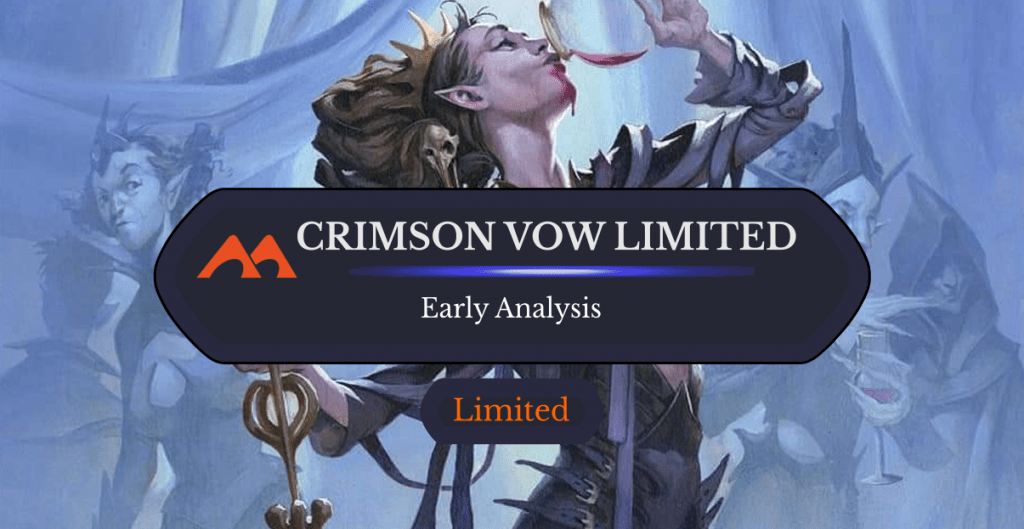
Gluttonous Guest | Illustration by Jesper Ejsing
With each new set comes a new guide to a new draft format. But before I get to the full ultimate guide (now available!), I wanted to experiment with a more hands-on analysis that isn’t treading quite the same space as most set reviews/overviews.
This writeup is aimed at players who will be battling it out in Sealed (and hopefully Draft Day 2) in Vegas this weekend, but really applies to anyone playing 40-card formats with Crimson Vow — whether that be at FNM, on MTGO, or on MTGA. Let's get started!
Archetypes and Mechanics
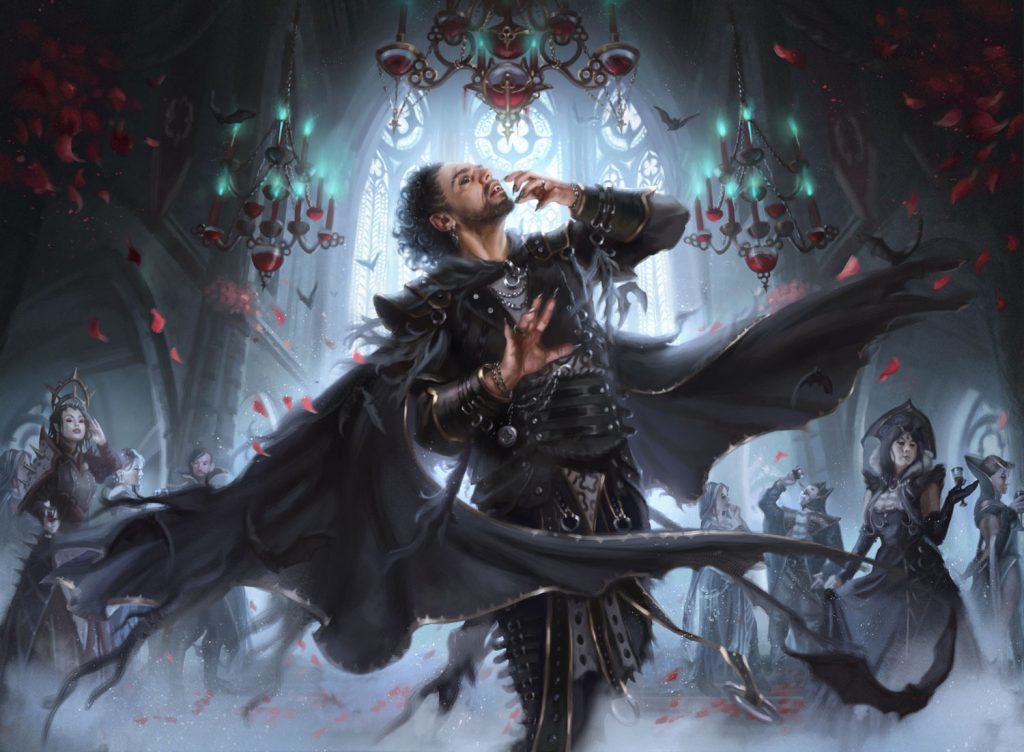
Restless Bloodseeker | Illustration by Justyna Gil
I want to go over some overarching concepts to the format to get us started. If you aren’t familiar with the basics of the format, please read this thread first!
Training
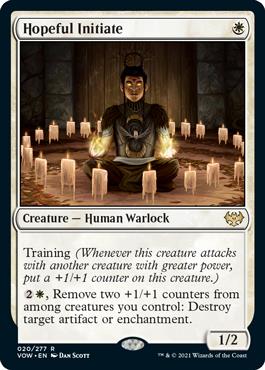
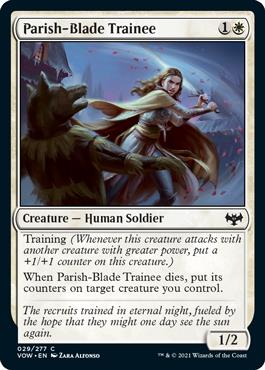
Training mostly played out a bit worse than I expected. It can be difficult to attack favorably with cards like Hopeful Initiate and Parish-Blade Trainee unless your opponent stumbles. Practical ways to mitigate this are pump spells and equipment, as well cards like Gryffwing Cavalry and Estwald Shieldbasher which were clearly printed with training in mind.
Disturb 2.0
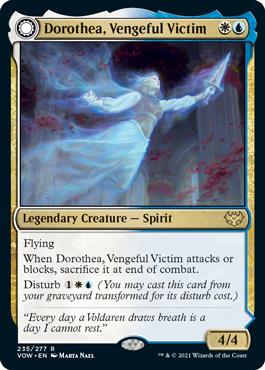
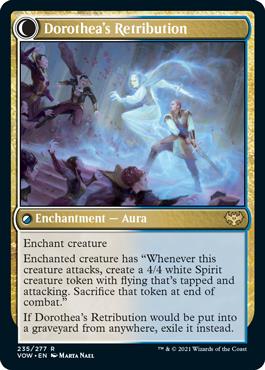
Transformed disturb cards being auras instead of creatures has the predicted effect of making Azorius () into a more aggressive color pair than it was. Most Azorius decks in Crimson Vow want to race their opponent with fliers/bounce spells while Midnight Hunt Azorius was much more capable of holding down the ground and translating trades into incremental advantages.
This important change informs a lot of smaller deckbuilding decisions in Azorius shells, making cards like Supernatural Rescue and Wanderlight Spirit better than they may appear.
Blood Tokens
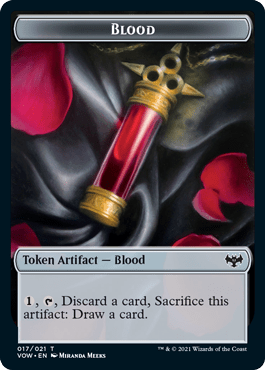
Blood is the set's main smoothing mechanic. It appears almost entirely on Rakdos () cards with a few small exceptions (Syphon Essence and Sigarda's Imprisonment plus two rares). As a “rummaging” mechanic that costs to activate, Blood's play pattern plays better with more mana than less.
You'd prefer to discard extra lands to Blood tokens rather than extra spells, which means that decks with high Blood counts should play 17 lands at minimum and never 16 or less. I’ve played 18 lands already in Sealed and been very pleased with it. I could even see 19 lands being justifiable with enough cards like Grisly Ritual.
Another aspect of Blood worth noting is that it has some diminishing returns on its own. This is because once you’ve addressed land/spell count imbalances through rummaging, you likely won't want to trade spells you have for random cards. An exception to this would be if you need to hit an out for lethal or to answer something broken like Toxrill, the Corrosive, in which case throwing away decent cards for your one of Hero's Downfall becomes a must.
Diminishing returns on Blood tokens matters far less when you have payoffs like Restless Bloodseeker, Anje, Maid of Dishonor, Voldaren Bloodcaster, and Wedding Security.
Exploit

Exploit‘s basic gameplay loop in VOW is to play a Persistent Specimen, Lantern Bearer, Wretched Throng, or Doomed Dissenter and then sacrifice it to any of nine exploit cards for value. There are also some uncommons like Undead Butler and Biolume Egg that make for even better fodder. Exploit can also be valuable against enchantment-based removal like Sigarda's Imprisonment and Fear of Death.
One exploit card that's been somewhat difficult to play for me is Repository Skaab. Balancing fodder creatures, exploit creatures, and targets for Repository Skaab is tricky and not always doable.
Butts Matter
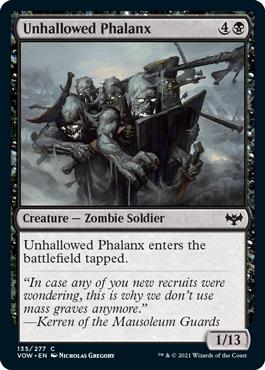
This is a powerful but narrow theme that's mostly limited to four payoffs: Ancient Lumberknot, Catapult Fodder, Flourishing Hunter, and (surprisingly) Geralf, Visionary Stitcher. These cards all leverage the normally terrible Unhallowed Phalanx to fantastic effect (13/13, deal 13, gain 13 life, or 13/13 again). One positive aspect of this theme is that the engine cards are all individually reasonable and lots of decent cards happen to be toughness-slanted.
Anatomy of a Crimson Vow Common

Syphon Essence | Illustration by Sean Murray
Rather than reviewing every common in the set, I wanted to contextualize a few into the larger picture of how they fit into 2-color archetypes.
Traveling Minister
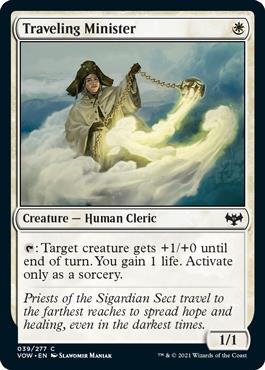
- This card is closer to Healer's Hawk than it may appear and has generally overperformed most player's expectations (myself included). If you can connect with whatever creature you're pumping, this is gain-1/deal-1 each turn which is much better than most 1-drops.
- This is a cheap and aggressive creature that helps you trade up/race in Boros () aggro. Good 1-drops are valuable in aggro decks and this is clearly a better card than Voldaren Epicure or Unholy Officiant.
- Selesnya () humans is generally aggressive just like Boros but probably gets even more leverage out of +1/+0 for training bumps. This is also a cheap human for Laid to Rest and Hamlet Vanguard.
- Orzhov () lifegain has several lifelinke-rs and a ton of lifegain synergy. A cheap source of lifegain/pump like this is great. Heron of Hope in particular combos very well with this, but it’s also a 0-mana enabler for Courier Bat.
- Azorius () has the most evasion and so it's the best archetype for Traveling Minister constantly dealing 1/gaining 1 each turn. Minister plays well with most builds given how tempo centric Azorius is (most games are races).
Skywarp Skaab

- Azorius () decks don't want anything this clunky, don't mill themselves or trade a ton, and have poor synergy with this because exiling dead disturb creatures is bad value.
- Dimir () is a much better fit for Skywarp Skaab since it likes the large flying body (disturb -> sacrifice gameplay leaves Dimir vulnerable to fliers), the zombie tribal, and naturally fills its yard with exploit junk.
- Skaab is playable in Izzet () but nothing special since the color combo has lower creature counts. Falkenrath Celebrants and Lacerate Flesh are generally preferable.
- Simic () has the most self-mill for this with Mulch and Moldgraf Millipede, but exiling two creature cards from your graveyard weakens a lot of your other cards. Not necessarily a deal breaker, but be careful and try not to play too many of these with those payoffs.
Gluttonous Guest
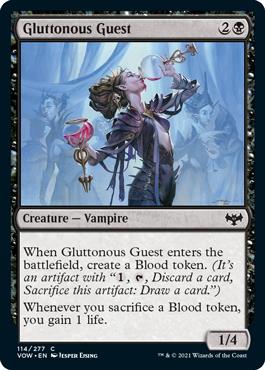
- From a Orzhov () lifegain perspective, Gluttonous Guest is a decent blocker that comes with a cheap source of lifegain to make your Courier Bat and Markov Purifier function.
- Rakdos () appreciates the tribe/Blood synergy, though your mileage depends on how controlling you are. Hyper-aggro should stay away while midrange decks leaning on Blood synergies will be very interested.
- Golgari () needs time to set up its synergies and enjoys the 1/4 sizing for Ancient Lumberknot.
- Dimir () has the least interest in this card since it isn’t particularly good to sacrifice or that powerful on its own.
Kessig Flamebreather
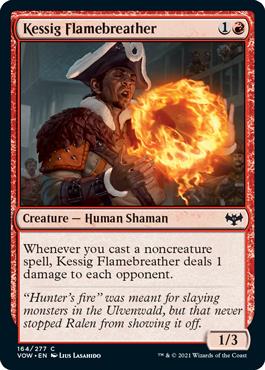
- Kessig Flamebreather is an example of a weak card without the tactical flexibility of the commons I've already gone over.
- Boros () wants more aggressive bodies than this and lacks non-creature spell density in general.
- Rakdos () can play this as filler but prefers Blood-Petal Celebrant or Ragged Recluse every time.
- Gruul () always prefers Sporeback Wolf or Hungry Ridgewolf to this.
- Izzet () is the only archetype that wants Kessig Flamebreather and should actually be pleased with how narrow and unwanted this card is since it plays well in multiples!
Apprentice Sharpshooter
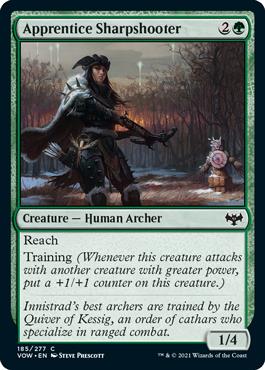
- Apprentice Sharpshooter is a decent card on rate that makes the cut in most decks.
- Selesnya () enjoys the human/training aspect of this card, though it can't train other 1/X trainees without help.
- Golgari () is more vulnerable to fliers than most with its largely ground based game plan. This is the only common with reach and is also a 1/4 for your toughness payoffs.
- Simic () needs to lock up the ground/air so it has time to Mulch and set up payoffs like Vilespawn Spider and Moldgraf Millipede. A 1/4 reach is a good fit.
- Gruul () is the color pair with the least interest in Sharpshooter. It can board them against Azorius or start them if it needs filler but prefers any of the 3-mana werewolves in a vacuum.
Sealed vs. Draft
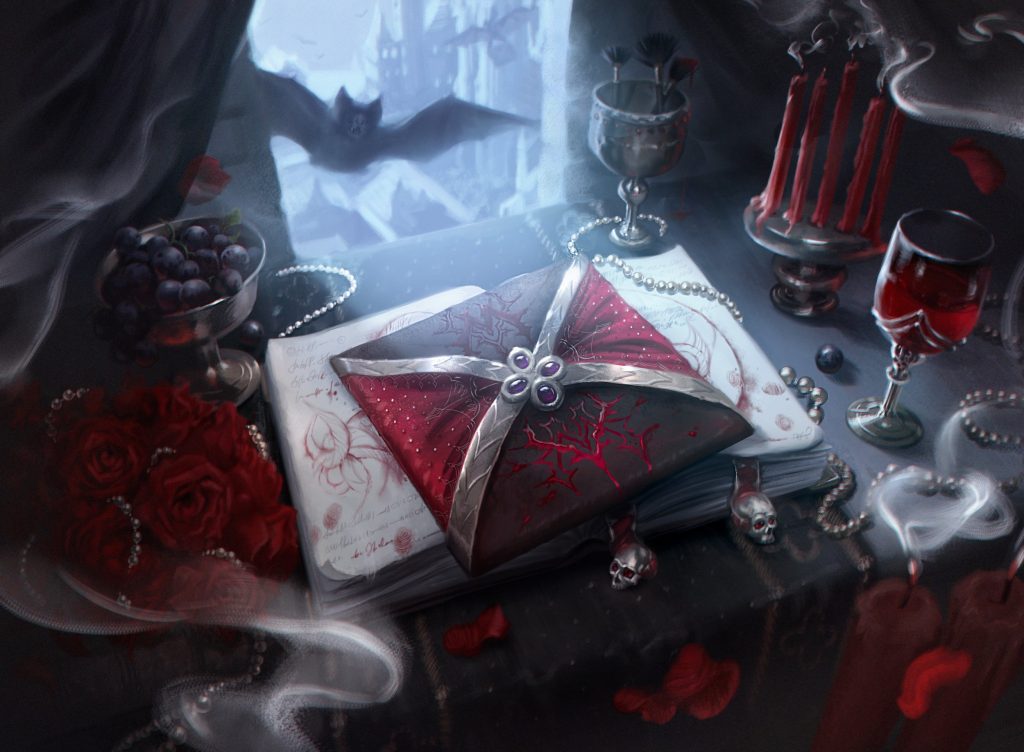
Wedding Invitiation | Illustration by Justyna Gil
Most people know the basics of Sealed vs Draft, but I'm happy to provide a recap if you need one:
- In Sealed you're given several colors/options and tasked to figure out the best one(s) for your pool. In Draft you build your own pool on the fly, best accomplished by reading other players and figuring out what deck configurations are “open.”
- Sealed is generally slower than Draft since players are thrown to the wolves of pack variance and often prioritize power over mana curve. Correct or not, this has the effect of players missing their 2-drops more often, increasing average game length.
- Sealed is also less synergistic than Draft. Cards like Brine Comber and Ancient Lumberknot want certain things (e.g., auras/disturb creatures and big butts) that your Sealed pool may not provide, so you should evaluate their power level in the context of your pool rather than by how good they are in Draft.
- Slower games/less synergy opens the way for individual card quality to matter more, leading to the timeless assertion that Sealed is dominated by bomb rares. Speaking of bombs…
Bombs and Crimson Vow
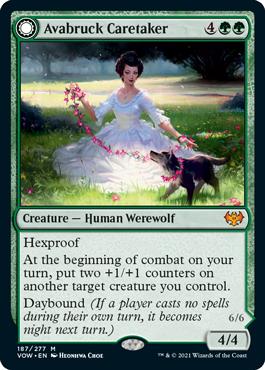
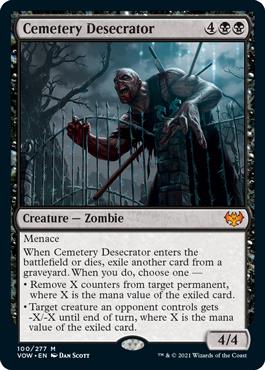
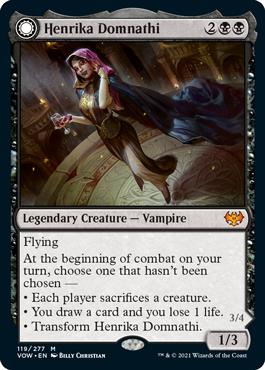
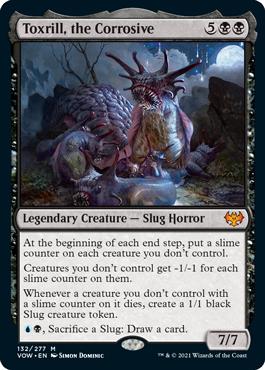


- Avabruck Caretaker
- Cemetery Desecrator
- Henrika Domanthi
- Toxrill, the Corrosive
- Dreadfast Demon
- Hullbreaker Horror
This is one of the bomb-iest sets in recent memory. A quick trip over to 17lands shows an unprecedented number of cards with over 65% win rate for being in hand at any point. This is particularly pronounced against decks since black has the highest concentration of obnoxious rares to an incredible degree. Four of the most broken rares are black but that’s not even mentioning Sorin the Mirthless, Anje, Maid of Dishonor, and Bloodvial Purveyor). So what’s to be done about this?
At the basic level you should play as many of these cards as you can if/when you open them. Even if it means sacrificing curve or consistency, this kind of power wins out just about every time. My green would have to be unbelievably bad to not play with Avabruck Caretaker. Same goes for black with any of these rares or blue with Hullbreaker Horror.
Beating Bombs
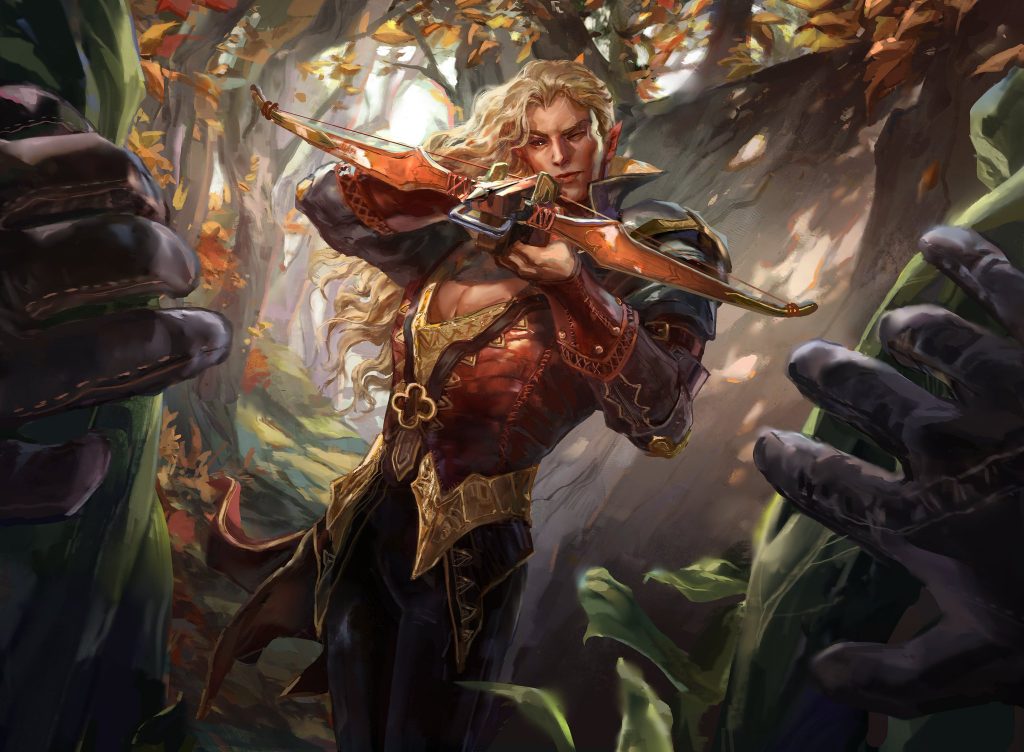
Voldaren Amubsher | Illustration by Evyn Fong
Even if you open bombs, you may still have to beat them. You may also not have opened any bombs, in which case you can complain about it all you want, but you still have to beat them to go deep in any Limited events.
How do you go about this? I'm so glad you asked.
Removal
The most obvious way to beat an obscenely powerful creature is to kill it. Black has the best time of this (Bleed Dry, Hero's Downfall, and Grisly Ritual) followed by white (Fierce Retribution). Red can answer certain rares like Henrika Domnathi but can't rely on its damage-based removal for the most intense ones.
This plan fails against recursion (Blood Fountain, Courier Bat, and Edgar's Awakening) or certain rares. Grisly Ritual does an admirable job against most rares but it likely won't save you against Dreadfast Demon and can't touch Avabruck Caretaker. Thank you Wizards, very cool!
When in doubt, start all the hard removal you can and remember your outs when your opponent slams something broken.
Counterspells
With Hullbreaker Horror as an infuriatingly lone exception, counterspells never looked better in Sealed. Syncopate, Syphon Essence, Geistlight Snare, and Wash Away are all playable and do a great job at stuffing 6+ mana cards.
The key with these cards is not falling behind to the point where you have to tap out if you can manage it. You also have to have the right game sense. If countering your opponent’s bait Falkenrath Celebrants can end the game, just do it. But if it won’t, think hard about whether or not you can counter that or save it for the Toxrill you lost to in game 1.
On the other hand, playing against counterspells with bombs is easy or hard depending on how the rest of the game is going. You want to tap your opponent out or “make them have it” when the window for your bomb to impact the game is about to close.
Discard
Targeted discard isn't generally beloved in Limited thanks to tempo concerns, but it still plays well against cards like Dreadfast Demon. Crimson Vow lacks a common 3-mana discard spell like Dark Inquiry, so your only options are Aim for the Head, Dread Fugue, and Concealed Curtains at rare.
Aim for the Head as a Mind Rot effect plays well against most 6- and 7-drops. You may be able to snipe your opponent's bomb before they can play it if they're playing out cards in their hand on their way to seven mana. Dread Fugue should almost always be cleaved in Limited where it acts as a Dark Inquiry effect that I recommend starting in most Sealed decks.
Count to 20
Aggression is the classic answer to unanswerable threats. If your opponent is dead on board the turn they cast Avabruck Caretaker, then hexproof doesn’t particularly matter, does it?
This is usually your best bet against the most broken cards in the format so you may want to have a backup aggro deck for when your deck is totally outclassed in card quality. You may also wish to play more creatures game 1 (even in your midrange/starting deck) to be better equipped to punish stumbles from greedy opponents.
Evaluating a Sealed Pool with Examples
Rather than just going over more concepts I wanted to give you a live demonstration of how you might approach building your Sealed pool in Vegas or on MTG Arena. I'll be using this pre-generated pool on Draftsim for this example, which you can try yourself if you're so inclined. I'll show you the final build a little later.
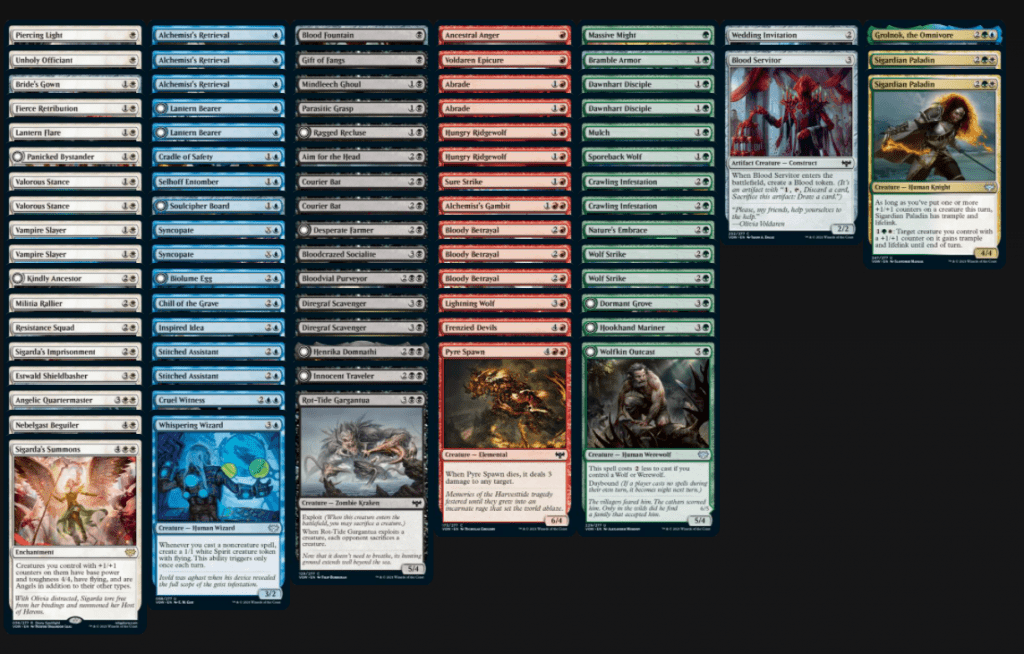
Rares
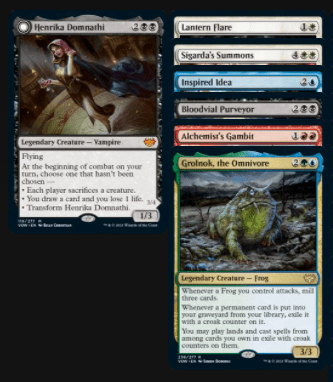
Rares are important, and a good place to begin with each pool. Let’s begin with ours here:
Henrika Domnathi

Henrika Domnathi was the third highest win rate on 17lands, basically Vampire Nighthawk that cantrips, Edicts, and pumps. A completely absurd bomb.
Lantern Flare
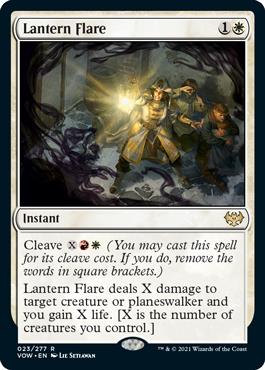
Lantern Flare is a solid white removal spell for creature-heavy decks with free lifegain attached that also has a Boros kicker mode that's useful if you're flooded. It's a good rare, but not a bomb.
Sigarda's Summons
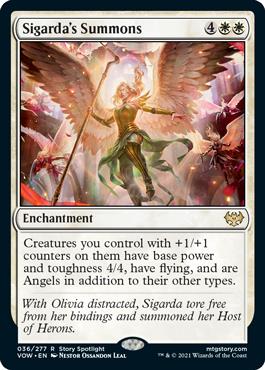
Search “counter” in your pool and look at how many cards show up, ignoring counterspells. Then type “training.” If neither returns much, feel free to hide Sigarda's Summons. This is because it’s an incredibly narrow but powerful build-around for Selesnya decks with lots of synergy. Occasionally a bomb, but it's usually unplayable.
Inspired Idea

Inspired Idea is decent as a draw-three sorcery, and the mode is pure upside for late game even if it's useless on turn 3. It's not a bomb but a solid playable.
Bloodvial Purveyor
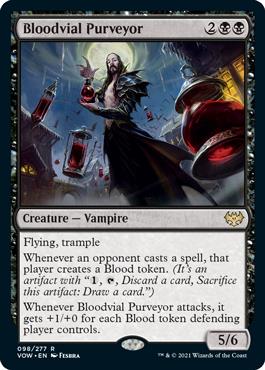
Bloodvial Purveyor is another black bomb rare, absurdly large for its cost with two forms of evasion to boot. It only has a slight drawback and can even pump its power if your opponent can’t use all their Bloods in time.
Alchemist's Gambit
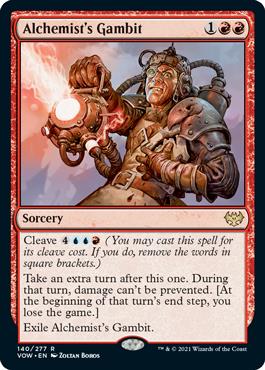
I’m only playing Alchemist's Gambit with access to blue mana, though you could try to use it as a Chance for Glory without blue if you wanted. This is too expensive/risky to be an excellent rare, but it at least feels playable in Izzet.
Grolnok, the Omnivore
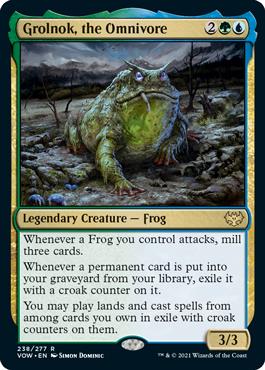
It’s hard for a Hill Giant with this good of an ability to survive combat, so good Grolnok, the Omnivore decks tend to have support cards like Mulch and Crawling Infestation to supplement it. Card advantage is always powerful, but I wouldn’t splash this without a deck for it.
Summary
We start with a strong bias towards from our rares. We can quickly do a check to figure out if Sigarda's Summons is playable by looking for “counters” and “training.”

Two Sigardian Paladins is great, but this pool doesn’t have a single card with the training mechanic. A handful of good uncommons can’t save us here, so we can safely throw Sigarda's Summons in the trash. Most cards aren’t this narrow, but this is a good practice with cards that are only playable with specific support.
Uncommons

The next thing I do on MTGA is give my uncommons a quick scroll down. You can do this in person by sorting the packs you open by rarity when you start your pool construction. (Click sort –> rarity in the example pool)
Here are some thoughts after seeing these uncommons:
- I'm immediately moving Bride's Gown to my “trash pile” since I don't have Groom's Finery and the card is very weak without it.
- I love a lot of white uncommons, all of which are good.
- Blue has a Dimir card, a decent Izzet-leaning card, and the slow/grindy Soulcipher Board. Egg is a good reason to check for exploit cards later since it’s nearly as narrow as Sigarda's Summons.
- Black doesn’t have much, but Innocent Traveler is a reasonable playable and Parasitic Grasp is a great removal spell. I’m thinking now that I have two bombs plus Grasp in black.
- Dormant Grove is generally good in decks with a high creature count. Wolfkin Outcast is weak without the discount but great with other wolves, and two Crawling Infestations play well with Grolnok.
- The two Paladins plus Grolnok are the only multicolor cards, but we already know that the Paladins aren’t amazing in this pool thanks to not having any training cards.
Overall Color View
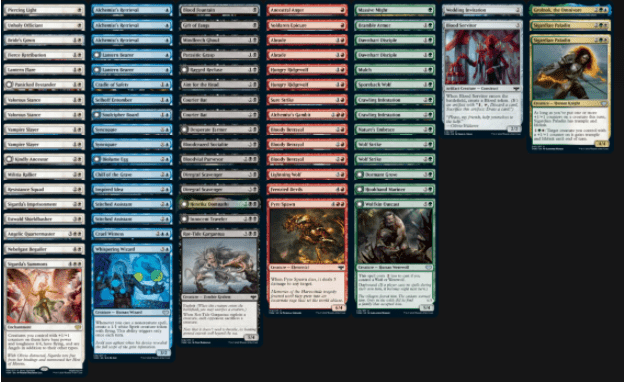
From here I just start viewing each color sorted vertically. This is a quick technique to assess which colors are deepest. Note that the Gown/Summons are to the right because they'd be hidden on Arena or in a separate pile in paper. From here we can start to evaluate each individual color.
White
Creatures
- Unholy Officiant (bad)
- 2x Vampire Slayer, Panicked Bystander
- Kindly Ancestor, Militia Rallier, Resistance Squad
- Estwald Shieldbasher
- Angelic Quartermaster, Nebelgast Beguiler
Removal
Assessment
White gives us a lot of playable removal, some early creatures, and a strong 5-drop in Angelic Quartermaster.
Blue
Creatures
- 2x Lantern Bearer
- Selhoff Entomber
- Biolume Egg, 2x Stitched Assistant
- Cruel Witness, Whispering Wizard
Counterspells
- 2x Syncopate
Card Advantage
Tempo
Assessment
Blue could be a good support color for black if our black has a good exploit base thanks to Egg/Assistant and Bearers to sacrifice. Not much raw power here.
Black
Creatures
- Mindleech Ghoul, Ragged Recluse
- 2x Courier Bat, Desperate Farmer
- Bloodcrazed Socialite, Bloodvial Purveyor, 2x Diregraf Scavenger, Henrika Domnathi, Innocent Traveler
- Rot-Tide Gargantua
Removal
Card Advantage
Assessment
Black is basically a lock to be one of our two main colors thanks to its bombs. The removal we get from it is below average for black, but better than nothing. Our secondary color should ideally be light on 4-drops as we have six playable 4-drops in this color alone.
Red
Creatures
Removal
- 2x Abrade
Other
Assessment
Red lacks creatures and good cards besides the two Abrades. Three Betrayals is notable but we don’t have enough cheap sacrifice effects to take advantage of this.
Green
Creatures
Removal
- 2x Wolf Strike
Graveyard Support
Other
Assessment
My pick for the worst color in our pool since we're shockingly creature-light for green. Wolf Strike doesn't play well with a low creature count/no Toxic Scorpions. Green’s graveyard setup cards play well with Grolnok, but our pool has almost nothing else to leverage them to any effect.
Colorless/Multicolor
There's only Wedding Invitation, an always-playable 23rd card/cantrip that's best in vampires/lifegain, and Blood Servitor, a generally bad filler that can be decent in Blood-focused decks, for colorless and Grolnok/Paladins for multicolor.
Building the Deck
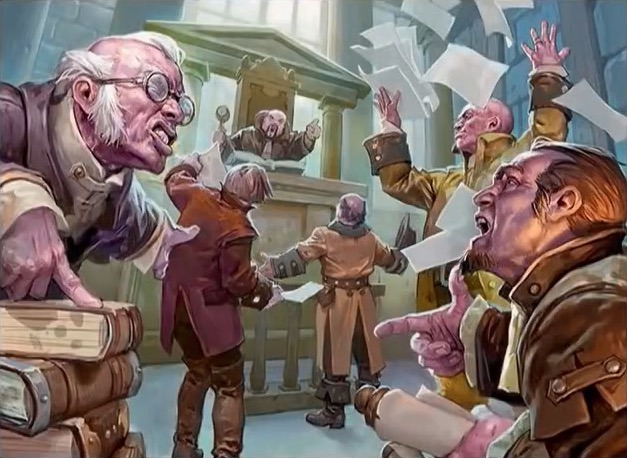
Disorder in the Court | Illustration by Zoltan Boros
We have no Evolving Wilds‘ and just one Nature's Embrace. We should pick a 2-color pair to play and not branch out into any other colors. Our goal is to take our black base and find the color that pairs best with it. What does 100% of our black playables look like?

This is 18 cards, but includes a number of cards we're not thrilled to play like Wedding Invitation and Blood Servitor. We also have six 4-drops, the worst of which are Innocent Traveler and Bloodcrazed Socialite. Our black needs hard removal and cheap creatures to complement its strengths. The best color for both is white by far.
Dragging all Orzhov playables together produces 33 cards, so we’ll need 10 cuts. Let’s go over what some of our cards need to understand this moving puzzle:
- Courier Bat is incredibly good here since we have a bunch of incidental lifegain on good cards plus two great rares to recur. Playing lifegain also makes our Panicked Bystander better. We should play all of our good lifegain cards.
- Ragged Recluse cares about Blood tokens and is basically just Goblin Piker without them. Our Blood tokens can only come from Blood Fountain, Blood Servitor, and Bloodcrazed Socialite. We have no other Blood payoffs or ways to make the tokens.
- Resistance Squad is only good when it draws a card, which requires another human. We have eight humans if you include Innocent Traveler but don’t need to play all eight for Squad to be good. At least five is fine.
- Sigarda's Imprisonment has poor synergy with Henrika’s Edict trigger and Rot-Tide Gargantua. Rot-Tide doesn't have anything amazing to sacrifice in this deck since we have no Doomed Dissenter. The same goes for Mindleech Ghoul which is usuallt just Walking Corpse.
- Our removal is very good and can cover small creatures and big creatures. I like to lean towards big creatures in game 1 and board into narrow removal like Piercing Light if necessary.
- We don’t have a ton of card advantage, just Courier Bat, Henrika Domnathi, and Aim for the Head.
Here's the deck I'd submit with that in mind:
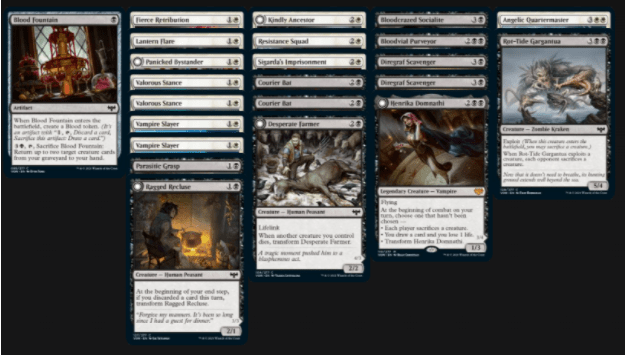
These are the main cards I'm not playing and why:
- Gift of Fangs is decent removal but I couldn’t fit it without cutting a creature so I didn’t bother including it. Lantern Flare took the slot I would’ve used for Gift. I'd still sideboard it in if I saw good enough targets, though.
- Mindleech Ghoul is outclassed by Ragged Recluse even with so little Blood because Recluse is a human for resistance squad. I'd swap it with Recluse against multiple Sigarda's Imprisonment, though.
- Aim for the Head was cut because I couldn’t find room since many of my cards like Lantern Flare, Blood Fountain, and Courier Bat want a higher creature density. Definitely comes in when it’s “exile target zombie,” though.
- Innocent Traveler versus Bloodcrazed Socialite is close, but I couldn’t afford / mana so I wanted to avoid a fourth card and have one more Blood generator for Recluse.
- Piercing Light won't always have targets and has a harsh timing restriction. It's better boarded in against aggro.
- Militia Rallier is my worst 3-drop in a vacuum and would need more 2-drops to consistently attack. This is another good card to board in against aggro since its stat line blocks well for its cost.
- Estwald Shieldbasher is slightly outclassed by other 4-drops.
- Nebelgast Beguiler has been okay for me, but Rot-Tide Gargantua seems like a stronger 5-drop even without a ton of creatures I want to sacrifice.
Here are the main cards I'd expect to trim after the sideboard:
- Ragged Recluse just barely made the deck, so I should take it out when I want to cut my worst 2-drops or cut Bloodcrazed Socialite for another 4-drop.
- Bloodcrazed Socialite and Rot-Tide Gargantua are mediocre enough that they’d be my first cuts for cheaper creatures/removal against aggro.
- Sigarda's Imprisonment is a serious liability against decks with a heavy exploit theme and is the only removal spell I'd expect to sometimes cut.
Wrap Up
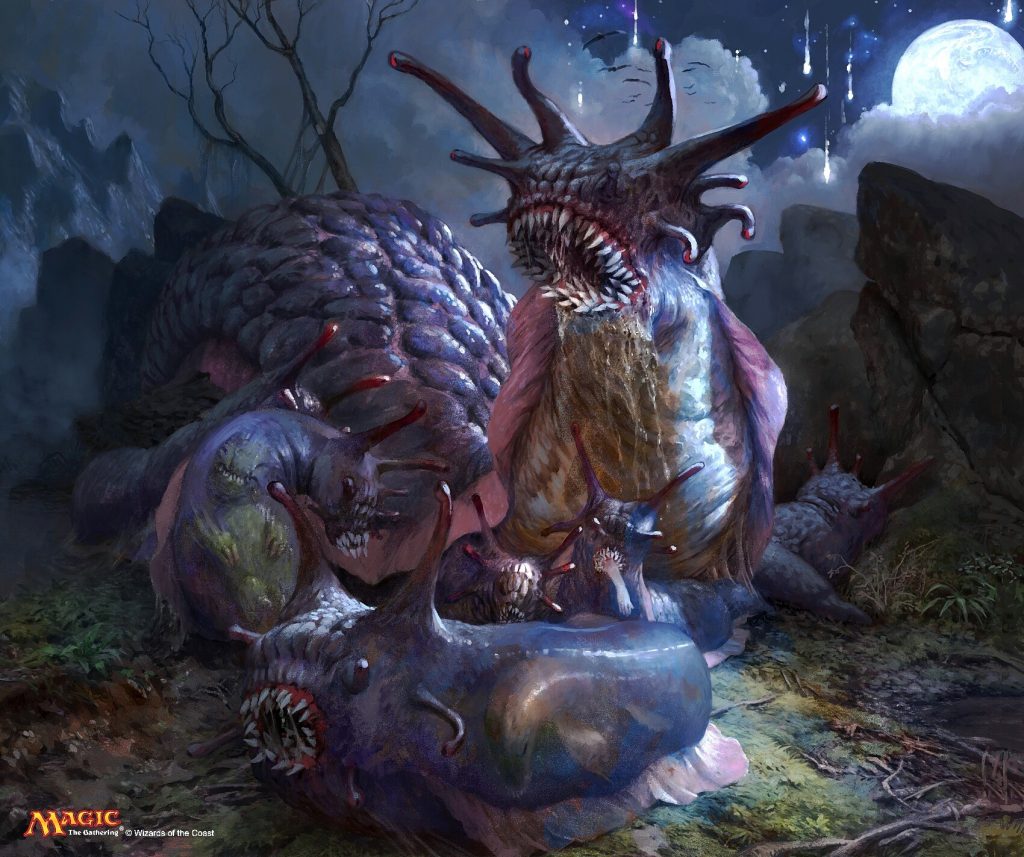
Toxrill, the Corrosive | Illustration by Simon Dominic
Whew, that was a lot of Crimson Vow to cover! Hopefully that live walkthrough helped. We'll go into more detail about Draft as opposed to Sealed soon, but if you make Day 2 at Vegas after this then I’d already feel happy enough with myself!
Good luck to all players battling it out there and to all players grinding online on MTG Arena and Magic Online. Let us know if you're competing and how you do in the comments down below, or find us on Twitter.
Finally, if you play limited on Arena, you need to be using Arena Tutor — it has my card ratings plus AI draft assistance to help you draft better!
May your opponents never open Toxrill, the Corrosive!
Follow Draftsim for awesome articles and set updates: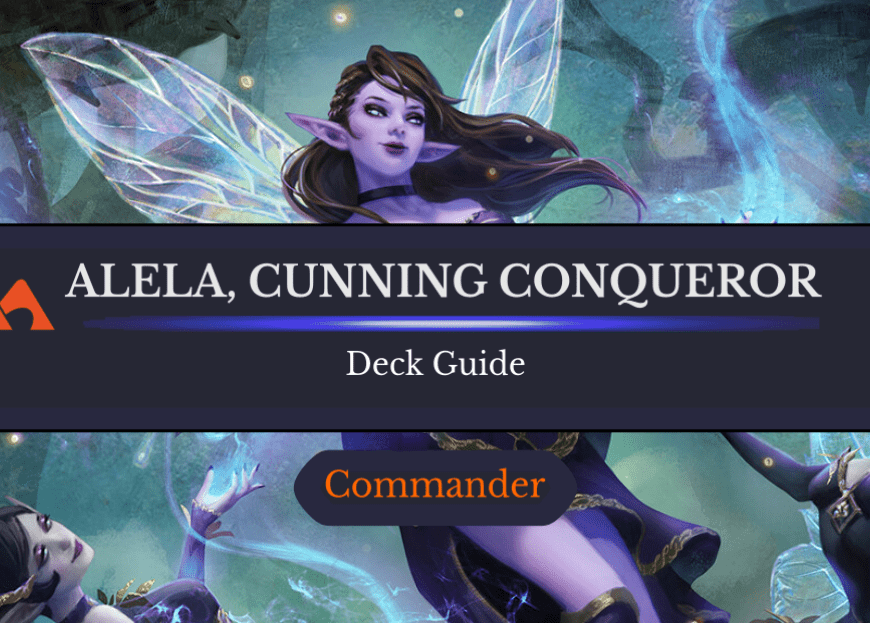
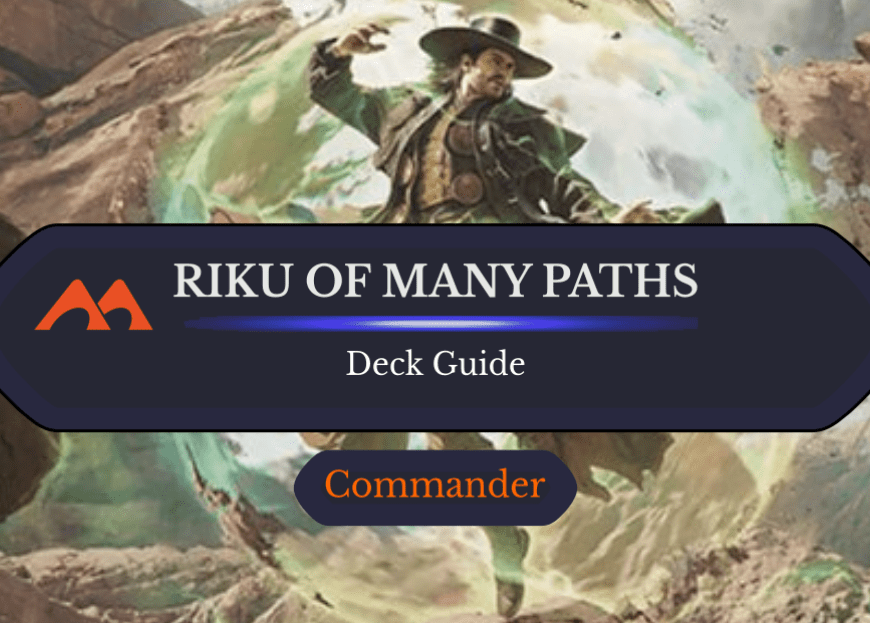
Add Comment